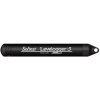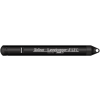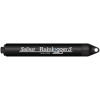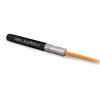Solinst Barologger 5 Barometric Pressure Logger
The Solinst Barologger 5 uses pressure algorithms based on air rather than water pressure to provide accuracy for barometric pressure compensation of Levelogger data.
Features
- Single-eye optical interface for easy cleaning and scratch-resistance
- Increased memory: 150,000 sets of data
- Data Compensation Wizard in the Levelogger Software simplifies barometric compensation
- Free ground shipping
- Expedited repair and warranty service
- Lifetime technical support
- More
Overview
The Solinst Barologger 5 is used to measure absolute pressure (water pressure + atmospheric pressure) expressed in feet, meters, centimeters, psi, kPa, or bar. The most accurate method of obtaining changes in water level is to compensate for atmospheric pressure fluctuations using a Barologger 5, avoiding time lag in the compensation.
Superior Accuracy
The Barologger 5 is set above high water level in one location on site. One Barologger can be used to compensate all Leveloggers in a 30 km (20 mile) radius and/or with every 300 m (1000 ft.) change in elevation. The Levelogger Software Data Compensation Wizard automatically produces compensated data files using the synchronized data files from the Barologger and Leveloggers on site. The Barologger 5 uses pressure algorithms based on air rather than water pressure, giving superior accuracy. The recorded barometric information can also be very useful to help determine barometric lag and/or barometric efficiency of the monitored aquifer.
Automatically Adjusts Measurements
The Barologger 5 records atmospheric pressure in psi, kPa, or mbar. When compensating submerged Levelogger 5, Edge, Gold or Junior data, Levelogger Software can recognize the type of Levelogger and compensate using the same units found in the submerged data file (e.g. feet or meters), making the Barologger 5 backward-compatible.
In The News
Wave-Powered Buoy Deployed in Puget Sound
While the development of solar-powered monitoring systems has improved access to real-time environmental data, solar power is still limited by low light conditions, such as poor weather, nighttime, or high-latitude environments. To supplement these incumbent power solutions at sea, Ocean Motion Technologies has developed a small-scale ocean wave energy system that can be directly integrated with existing data buoy platforms. Not only does wave energy supplement solar power during periods when the buoys are limited by light availability, but it also allows data buoys to perform beyond their current power capacities.
Read MoreLong-Term Monitoring in the Chautauqua Lake Watershed
With a widely developed shoreline, Chautauqua Lake experiences influxes of non-point source pollution that have historically impacted the health of the lake. The Chautauqua Lake Association (CLA) has been monitoring the lake for over two decades, reporting on changes that have occurred over the years. A pair of local lake advocates, Jane and Doug Conroe, have lived on the lake for over 40 years and have played an important role in establishing monitoring programs and facilitating consistent data collection throughout the watershed. Doug has been involved with the Chautauqua Lake Association (CLA) since the pair moved to the area in 1980, and is currently serving as the Executive Director.
Read MoreNo Red Herrings: Data Driving the Largest Salt Marsh Restoration in the NE USA
The Herring River system encompasses around 1,000 acres in the Towns of Wellfleet and Truro, Massachusetts. In 1909, the Chequessett Neck Road dike was built at the river’s mouth, drastically limiting tidal flow. Today, it’s one of the most restricted estuaries in the northeastern United States. As a result, the area has suffered environmental decline, including poor water quality, hypoxia, lower pH, and salt marsh degradation. In 2023, the Town of Wellfleet received $14.7 million from NOAA’s Office of Habitat Conservation to fund the Herring River Restoration Project (HRRP). Francesco Peri, President and CEO at Charybdis Group LLC, uses a network of NexSens data loggers to monitor water level and water quality on the Herring River.
Read More


















































